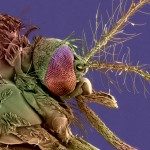Link to Pubmed [PMID] – 18000540
PLoS ONE 2007;2(11):e1168
BACKGROUND: A Chikungunya (CHIK) outbreak hit La Réunion Island in 2005-2006. The implicated vector was Aedes albopictus. Here, we present the first study on the susceptibility of Ae. albopictus populations to sympatric CHIKV isolates from La Réunion Island and compare it to other virus/vector combinations.
METHODOLOGY AND FINDINGS: We orally infected 8 Ae. albopictus collections from La Réunion and 3 from Mayotte collected in March 2006 with two Chikungunya virus (CHIKV) from La Réunion: (i) strain 05.115 collected in June 2005 with an Alanine at the position 226 of the glycoprotein E1 and (ii) strain 06.21 collected in November 2005 with a substitution A226V. Two other CHIKV isolates and four additional mosquito strains/species were also tested. The viral titer of the infectious blood-meal was 10(7) plaque forming units (pfu)/mL. Dissemination rates were assessed by immunofluorescent staining on head squashes of surviving females 14 days after infection. Rates were at least two times higher with CHIKV 06.21 compared to CHIKV 05.115. In addition, 10 individuals were analyzed every day by quantitative RT-PCR. Viral RNA was quantified on (i) whole females and (ii) midguts and salivary glands of infected females. When comparing profiles, CHIKV 06.21 produced nearly 2 log more viral RNA copies than CHIKV 05.115. Furthermore, females infected with CHIKV 05.115 could be divided in two categories: weakly susceptible or strongly susceptible, comparable to those infected by CHIKV 06.21. Histological analysis detected the presence of CHIKV in salivary glands two days after infection. In addition, Ae. albopictus from La Réunion was as efficient vector as Ae. aegypti and Ae. albopictus from Vietnam when infected with the CHIKV 06.21.
CONCLUSIONS: Our findings support the hypothesis that the CHIK outbreak in La Réunion Island was due to a highly competent vector Ae. albopictus which allowed an efficient replication and dissemination of CHIKV 06.21.
